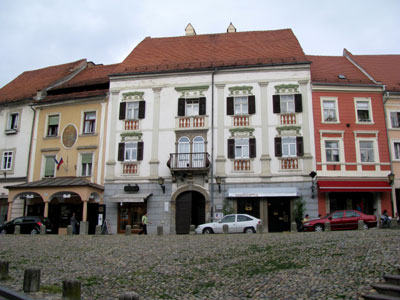After my upper Styrian driving tour the day before, my brother and I headed out on another driving tour, this time going south to Lower Styria, a region located in today’s Slovenia. Being located in the southern part of Austria and in the heart of Europe, it is extremely easy to go on local excursions as the distances are very short and the road systems are well developed. Today our destination was Ptui, a town with about 23,000 residents, that is the capital of Lower Styria.
As a matter of fact, Ptui (in German”Pettau”) used to be part of the Austro-Hungarian Empire until 1918 when the empire collapsed and Lower Styria, the region surrounding Ptuj, became part of Yugoslavia. Ptuj was actually inhabited as early as the Stone Age, and was settled by Celtic tribes by the late Iron Age. The town took on specific importance in the first century AD, when Ptuj was first mentioned as a Roman settlement called Poetovio, which was the headquarters of an important Roman legion.

Colourful facades in Ptuj
Over the next few centuries Ptuj saw a veritable army of foreign conquerors, including the Avars, Slavs and Franks. By 1555 Ptuj was incorporated into the Duchy of Styria and in the early 20th century more than 85% of residents spoke German. This naturally changed after World War I. After 1945 the German speaking population was expelled to Austria and quite a large number later settled in North America.

Slovenski Trg
Having arrived in Ptuj at roughly 11 am, we parked our vehicle close to the market square which was teeming with local merchants selling home-grown produce. The mild climate in Slovenia already provided harvests of delicious looking local fruits and vegetables. The Church of St. George is the most prominent building on Ptuj’s main square, Slovenski Trg. Gothic in style, it features some Roman-era windows. Adjacent to the church is the Town’s Tower, first mentioned in 1376 in the Town’s Statute. It is joined by the Orpheus Monument, a Roman-era tombstone with a height of almost 5 m. This was the biggest tombstone ever to be found in the Roman province of Upper Pannonia.

Ptuj’s Orpheus Monument
Turning left on the narrow Slovenski Trg square we headed downhill to a major square called Mestni Trg. It is anchored by the Town Hall, an Art Nouveau building completed in 1907. Today’s city administration is still located in this building. From here we headed down some narrow streets towards the banks of the Drava River which is crossed by several bridges before it opens up to a large reservoir. Strolling back northwards we aimed to visit Ptuj Castle, which is strategically located on a hill overlooking the Drava River. The first settlers had lived here as early as around 2000 BC. Today some of the pottery and artifacts from this era are preserved in the Ptuj Regional Museum.

Architectural details in Ptuj
During Roman times, a small fortress and basilica were built on this hill. Today’s castle was first mentioned in the early 12th century although the records refer to an earlier castle that had already been demolished by that time. Today’s Ptuj Castle was considered one of the mightiest until the time of the Turkish invasions. The castle has an attractive Renaissance-era courtyard and provides excellent views over the southern and western part of town and the Drava River.

After an enjoyable time in the castle’s courtyard we strolled down into the downtown area again and sat down for a quick lunch on a restaurant patio just steps away from the Town Hall. With all the people strolling and relaxing on the patios, Ptjui had an almost Mediterranean feel to it.

Ptuj’s city hall
In the early afternoon we decided to make our way home to Austria from Slovenia and drove northwards past the city of Maribor, the country’s second largest city. Rather than taking the highway, we snaked our way through small roads on rolling hills covered by vineyards. Slovenia has become a popular travel destination for Central Europeans, due to its topographical variety which ranges from Mediterranean beaches to the high peaks of the Julian Alps and the rolling hills and plains of the south. The region of Lower Styria is so close to Austria that many southern Austrians go there for day trips to hike, bike, ski or enjoy short city getaways.

View from Ptuj’s castle
After our arrival back in Eastern Styria in the late afternoon I took a brief rest and then got ready to pack my bags because a whole new adventure was set to start: tomorrow I would fly out to Mallorca, one of Spain’s most popular islands in the Mediterranean – a destination I had wanted to explore for a long time.
Related Videos:
Market square in Ptuj
Art Nouveau city hall in Ptuj
Slovenskij Trg in Ptuj with church and Roman gravestone
Interior courtyard of the Castle of Ptuj
